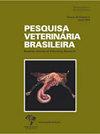牛肉芽胞杆菌的不同诊断方法检测
IF 0.8
4区 农林科学
Q3 VETERINARY SCIENCES
引用次数: 0
摘要
摘要:牛被认为是肌囊虫病的中间宿主,在感染的急性期可引起临床症状和性能下降。在尸检时,通常肉眼无法看到肉囊菌。此外,新鲜显微镜检查和透射电子显微镜技术难以应用于大样本。因此,需要利用分子和血清学方法对牛的肌囊虫感染进行广泛的研究。本研究采用新鲜显微镜检查和心肌样品聚合酶链反应检测牛肌囊菌感染情况,并与间接荧光抗体检测相应血清样品中肌囊菌抗体的检测结果进行比较。显微镜下心肌标本中100%可见肌囊虫,86%(43/50)的心肌标本中存在肌囊虫DNA。在1:25和1:20 00稀释条件下,分别有96%(48/50)和80%(40/50)的血清样品检测到肌囊虫抗体。三种相关方法(新鲜镜检、PCR和血清学)对肉囊菌的敏感性和检出率均优于单纯新鲜镜检,可用于活体动物的大规模诊断和畜群状况监测。本文章由计算机程序翻译,如有差异,请以英文原文为准。
Sarcocystis spp. detection in cattle using different diagnostic methods
ABSTRACT: Cattle are considered intermediate hosts of Sarcocystis, which can cause clinical signs and lower performance in the acute phase of infection. Sarcocystis spp. are usually not visible to the naked eye during the post mortem inspection. Moreover, fresh microscopic examination and transmission electron microscopy techniques are difficult to apply to large samples. Therefore, extensive studies on Sarcocystis infection in cattle using molecular and serological methods are required. Here, we investigated Sarcocystis spp. infection in cattle using fresh microscopic examination and polymerase chain reaction of myocardium samples and compared the results with the presence of antibodies against Sarcocystis spp. in corresponding serum samples detected using indirect fluorescent antibody test. Microscopic Sarcocystis were observed in 100% of the myocardial samples, and Sarcocystis DNA was present in 86% (43/50) of these samples. Antibodies against Sarcocystis spp. were detected in 96% (48/50) and 80% (40/50) of the serum samples at 1:25 and 1:200 dilutions, respectively. The three associated methods (fresh microscopic examination, PCR and serology) showed good sensitivity and detection for Sarcocystis spp. compared with fresh microscopic examination (only), and they may facilitate diagnosis in live animals on a large scale as well as monitoring of the herd status.
求助全文
通过发布文献求助,成功后即可免费获取论文全文。
去求助
来源期刊

Pesquisa Veterinaria Brasileira
农林科学-兽医学
CiteScore
1.30
自引率
16.70%
发文量
41
审稿时长
9-18 weeks
期刊介绍:
Pesquisa Veterinária Brasileira - Brazilian Journal of Veterinary Research (http://www.pvb.com.br), edited by the Brazilian College of Animal Pathology in partnership with the Brazilian Agricultural Research Organization (Embrapa) and in collaboration with other veterinary scientific associations, publishes original papers on animal diseases and related subjects. Critical review articles should be written in support of original investigation. The editors assume that papers submitted are not being considered for publication in other journals and do not contain material which has already been published. Submitted papers are peer reviewed.
The abbreviated title of Pesquisa Veterinária Brasileira is Pesqui. Vet. Bras.
 求助内容:
求助内容: 应助结果提醒方式:
应助结果提醒方式:


